Chinese Journal of Tissue Engineering Research ›› 2024, Vol. 28 ›› Issue (27): 4383-4389.doi: 10.12307/2024.553
Previous Articles Next Articles
Effects of kinesio taping on the biomechanical characteristics of the lower limbs during side-step cutting
You Jing, Huang Wenqi, Zheng Wei, Lu Jieming, Guo Yanhua, Gao Yuan, Xiong Zheyu
- Tianjin University of Sport, Tianjin 301617, China
-
Received:2023-10-13Accepted:2023-11-10Online:2024-09-28Published:2024-01-29 -
Contact:Zheng Wei, Associate professor, Tianjin University of Sport, Tianjin 301617, China -
About author:You Jing, Master, Tianjin University of Sport, Tianjin 301617, China -
Supported by:the Scientific Research Foundation of Tianjin Education Commission, No. 2020KJ101 (to ZW); Undergraduate Teaching Quality and Reform Research Project of Colleges and Universities in Tianjin, No. B231007102 (to ZW)
CLC Number:
Cite this article
You Jing, Huang Wenqi, Zheng Wei, Lu Jieming, Guo Yanhua, Gao Yuan, Xiong Zheyu. Effects of kinesio taping on the biomechanical characteristics of the lower limbs during side-step cutting[J]. Chinese Journal of Tissue Engineering Research, 2024, 28(27): 4383-4389.
share this article
Add to citation manager EndNote|Reference Manager|ProCite|BibTeX|RefWorks
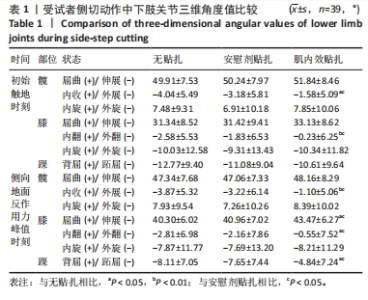
2.1 参与者数量分析 纳入受试者39名,均完成3种测试,其测试数据全部进入结果分析。 2.2 下肢关节在侧切动作任务中运动学指标比较 2.2.1 初始触地时刻 3种情况下测试结果比较,经单因素重复测量方差分析,髋关节外展角度(F=7.168,P=0.001)及膝关节外翻角度(F=7.590,P < 0.001)差异有显著性意义,其他运动学指标均未见统计学差异(P > 0.05)。进一步事后检验发现,与无贴扎及安慰剂贴扎相比,肌内效贴扎可显著减小髋关节外展角度(P=0.002,P=0.016)、膝关节外翻角度(P < 0.001,P=0.004),且无贴扎与安慰剂贴扎之间差异无显著性意义(髋关节外展P=0.163,膝关节外翻P=0.262),见表1。"
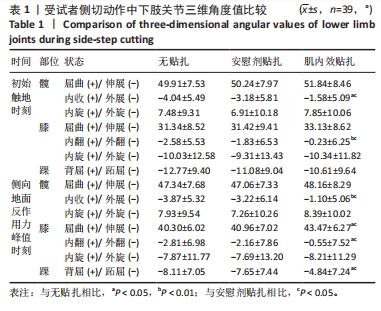
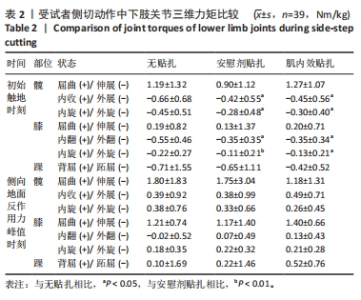
2.2.2 侧向地面反作用力峰值时刻 3种情况下测试结果比较,经单因素重复测量方差分析,侧向地面反作用力峰值时刻髋关节外展角度(F=8.985,P < 0.001)、膝关节屈曲角度(F=6.269,P=0.003)、外翻角度(F=4.798,P=0.011)、踝关节跖屈角度(F=5.599,P=0.005)差异有显著性意义,其他运动学指标均未见统计学差异(P > 0.05)。进一步事后检验发现,与无贴扎及安慰剂贴扎相比,肌内效贴扎条件下可显著减小髋关节外展角度(P < 0.001,P=0.005)、膝关节外翻角度(P=0.010,P=0.016)及踝关节跖屈角度(P=0.004,P=0.013),显著增加膝关节屈曲角度(P=0.004,P=0.009);上述指标在无贴扎和安慰剂贴扎条件下差异无显著性意义(髋关节外展P=0.326,膝关节屈曲P=0.458,膝关节外翻P=0.406,踝关节跖屈P=0.658),见表1。 2.3 下肢关节在侧切动作任务中关节力矩比较 3种情况下测试结果比较,经单因素重复测量方差分析可知:初始触地时刻髋关节外展(F=5.717,P=0.005)、外旋(F=3.949,P=0.023)力矩、膝关节外翻(F=8.756,P < 0.001)、外旋(F=11.108,P < 0.001)力矩差异有显著性意义,其他指标均未见统计学差异(P > 0.05)。进一步事后检验发现,肌内效贴扎和安慰剂贴扎均可显著减小髋关节外展(P=0.006,P=0.010)和外旋(P=0.018,P=0.021)力矩以及膝关节外翻(P=0.002,P=0.001)和外旋(P=0.002,P < 0.001)力矩,但二者之间差异无显著性意义(髋关节外展P=0.691、外旋P=0.748,膝关节外翻P=0.914、外旋P=0.172)。侧向地面反作用力峰值时刻时3种条件之间各指标均未见统计学差异(P > 0.05),见表2。"
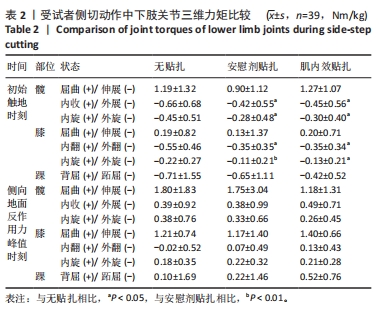
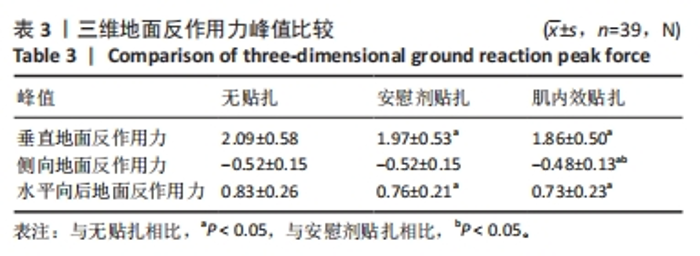
2.4 三维地面反作用力峰值比较 经单因素重复测量方差分析可知: 垂直地面反作用力峰值(F=7.004,P=0.002)、侧向地面反作用力峰值(F=2.830,P=0.049)、水平向后地面反作用力峰值(F=6.994,P=0.002)均具有统计学差异。进一步事后检验发现,与无贴扎相比,肌内效贴扎和安慰剂贴扎均可显著减小垂直地面反作用力峰值(P=0.001,P=0.049)、水平向后地面反作用力峰值(P=0.002,P=0.009),但肌内效贴扎与安慰剂贴扎之间差异无显著性(P=0.071,P=0.211)。与无贴扎及安慰剂贴扎相比,肌内效贴扎可显著减小侧向地面反作用力峰值(P=0.046,P=0.031),但无贴扎与安慰剂贴扎之间无显著性(P=0.967),见表3。"
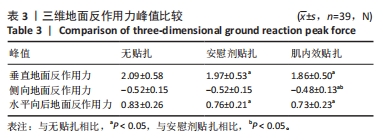
| [1] MINGHELLI B, QUEIROZ S, SOUSA I, et al. Musculoskeletal injuries in basketball players southern portugal: epidemiology and risk factors. North Clin Istanb. 2022;9(1):14-22. [2] FOX A, SPITTLE M, OTAGO L, et al. Offensive agility techniques performed during international netball competition. Int J Sports Sci Coa. 2014;9(3):543-552. [3] SWEETING AJ, AUGHEY RJ, CORMACK SJ, et al. Discovering frequently recurring movement sequences in team-sport athlete spatiotemporal data. J Sport Sci. 2017;35(24):2439-2445. [4] KIAPOUR AM, MURRAY MM. Basic science of anterior cruciate ligament injury and repair. Bone Joint Res. 2014;3(2):20-31. [5] MORRIS SN, CHANDRAN A, LEMPKE LB, et al. Epidemiology of injuries in National Collegiate Athletic Association men’s basketball: 2014-2015 through 2018-2019. J Athl Train. 2021;56(7):681-687. [6] PODRAZA JT, WHITE SC. Effect of knee flexion angle on ground reaction forces, knee moments and muscle co-contraction during an impact-like deceleration landing: implications for the non-contact mechanism of ACL injury. Knee. 2010;17(4):291-295. [7] KOGA H, NAKAMAE A, SHIMA Y, et al. Mechanisms for noncontact anterior cruciate ligament injuries: knee joint kinematics in 10 injury situations from female team handball and basketball. Am J Sports Med. 2010;38(11): 2218-2225. [8] WALDéN M, KROSSHAUG T, BJøRNEBOE J, et al. Three distinct mechanisms predominate in non-contact anterior cruciate ligament injuries in male professional football players: a systematic video analysis of 39 cases. Brit J Sport Med. 2015;49(22):1452-1460. [9] DONELON T A, DOS’SANTOS T, PITCHERS G, et al. Biomechanical determinants of knee joint loads associated with increased anterior cruciate ligament loading during cutting: a systematic review and technical framework. Sports Med Open. 2020;6(1):53. [10] 李尚华,王海燕. 直线前进变换为侧向跨步切入动作时的下肢生物力学变化[J]. 中国组织工程研究,2020,24(8):1260-1266. [11] DOS’SANTOS T, THOMAS C, MCBURNIE A, et al. Biomechanical Determinants of Performance and Injury Risk During Cutting: A Performance-Injury Conflict? Sports Med. 2021;51(9):1983-1998. [12] FOX AS. Change-of-Direction biomechanics: Is what’s best for anterior cruciate ligament injury prevention also best for performance?. Sports Med. 2018;48(8):1799-1807. [13] MANIAR N, COLE MH, BRYANT AL, et al. Muscle force contributions to anterior cruciate ligament loading. Sports Med. 2022;52(8):1737-1750. [14] ENGEBRETSEN L, WIJDICKS CA, ANDERSON CJ, et al. Evaluation of a simulated pivot shift test: a biomechanical study. Knee Surg Sports Traumatol Arthrosc. 2012;20(4):698-702. [15] SIGURðSSON HB, KARLSSON J, SNYDER-MACKLER L, et al. Kinematics observed during ACL injury are associated with large early peak knee abduction moments during a change of direction task in healthy adolescents. J Orthop Res. 2021;39(10):2281-2290. [16] HEWETT TE, FORD KR, HOOGENBOOM BJ, et al. Understanding and preventing ACL injuries: current biomechanical and epidemiologic considerations-update 2010. N Am J Sports Phys Ther. 2010;5(4):234-251. [17] DELLA VILLA F, TOSARELLI F, FERRARI R, et al. Systematic video analysis of anterior cruciate ligament injuries in professional male rugby players: pattern, injury mechanism, and biomechanics in 57 consecutive cases. Orthop J Sports Med. 2021;9(11):23259671211048182. [18] SUGIMOTO D, ALENTORN-GELI E, MENDIGUCHÍA J, et al. Biomechanical and neuromuscular characteristics of male athletes: implications for the development of anterior cruciate ligament injury prevention programs. Sports Med. 2015;45(6):809-822. [19] PAOLONI M, BERNETTI A, FRATOCCHI G, et al. Kinesio taping applied to lumbar muscles influences clinical and electromyographic characteristics in chronic low back pain patients. Eur J Phys Rehabil Med. 2011;47(2): 237-244. [20] 段高营,罗炯,刘立,等. 膝关节防护与康复中肌内效贴扎的生物力学作用及优势[J].中国组织工程研究,2018,22(31):5062-5068. [21] TU SJ, WOLEDGE RC, MORRISSEY D. Does ‘Kinesio Tape’ alter thoracolumbar fascia movement during lumbar flexion an observational laboratory study. J Bodyw Mov Ther. 2016;20(4):898-905. [22] ZHANG S, FU W, PAN J, et al. Acute effects of kinesio taping on muscle strength and fatigue in the forearm of tennis players. J Sci Med Sport. 2016; 19(6):459-464. [23] 程慧,赵菁,牛秀莲,等. 肌内效贴在改善脑瘫儿童步态中的应用[J].中国康复医学杂志,2015,30(1):47-49. [24] 中国肌内效贴技术临床应用专家共识组.中国肌内效贴技术临床应用专家共识(2020版)[J]. 中华物理医学与康复杂志,2021,43(2):97-108. [25] CIMINO SR, BEAUDETTE SM, BROWN S. Kinesio taping influences the mechanical behaviour of the skin of the low back: a possible pathway for functionally relevant effects. J Biomech. 2018;67:150-156. [26] 刘立,张庭然,罗炯,等.不同类型贴扎对急停时膝关节的影响[J].中国康复理论与实践,2018,24(11):1349-1354. [27] NOKHODCHI N, HOSSEINI M, ATTARAN IRAJ Z, et al. The effects of kinesio-tape through facilitation of hamstring and inhibition of quadriceps on biomechanical variables affecting anterior cruciate ligament injury when landing in active healthy young women. J Adv Sport Technol. 2020;4(2): 104-113. [28] LIMROONGREUNGRAT W, BOONKERD C. Immediate effect of ACL kinesio taping technique on knee joint biomechanics during a drop vertical jump: A randomized crossover controlled trial. BMC Sports Sci Med Rehabil. 2019;11:32. [29] 陈文华. 肌内效贴技术的临床应用及机制述评[J]. 华西医学,2021,36(5): 561-565. [30] 裴子文,汪冕,言功立,等. 肌内效贴治疗慢性踝关节不稳的即刻及短期疗效观察[J].中国康复,2020,35(9):463-466. [31] LEMOS TV, SANTOS M, JúNIOR J, et al. Kinesio taping effects on the electromyography activity: a controlled randomized and blinded clinical trial. Phys Ther Sport. 2016;18:5. [32] 鲁智勇. 橄榄球运动员侧切跑膝关节生物力学特征及ACL损伤康复理论研究[D]. 北京:北京体育大学,2016. [33] KASE KWJ, KASE T. Clinical therapeutic applications of the kinesio taping method.2nd.Tokyo. Japan: Ken I Kai Co Ltd. 2003. [34] 贺小桦,陈方灿.功能性贴扎技术[M].北京:电子工业出版社,2019:86. [35] 邹利民, 毛丽娟, 梁雷超,等. 非预期条件下女足运动员侧切动作中膝关节运动生物力学特性[J].上海体育学院学报,2019,43(5):77-83. [36] HAMZAH A, BERLIANA B, PITRIANI P, et al. The effects of kinesio taping on the lower-body injury rehabilitation in female futsal athletes.4th International Conference on Sport Science, Health, and Physical Education (ICSSHPE 2019). 2020:144-147. [37] 邹利民, 毛丽娟, 伍勰,等. 疲劳与非预期效应对女子足球运动员侧切动作中膝关节生物力学的影响[J].中国体育科技,2019,55(7):14-21. [38] 张美珍, 刘卉, 李翰君,等. 侧切和急停起跳对篮球运动员前交叉韧带运动生物力学特征的影响[J]. 北京体育大学学报,2015,38(4):65-70. [39] DAVID S, KOMNIK I, PETERS M, et al. Identification and risk estimation of movement strategies during cutting maneuvers. J Sci Med Sport. 2017; 20(12):1075-1080. [40] 郭浩,刘瑞瑞,王广宇,等.足球运动员专项疲劳对其ACL损伤高危动作运动学特征的影响[J].中国体育科技,2021,57(7):53-61. [41] MCLEAN SG, HUANG X, SU A, et al. Sagittal plane biomechanics cannot injure the ACL during sidestep cutting. Clin Biomech (Bristol, Avon). 2004; 19(8):828-838. [42] SCHROEDER LE, WEINHANDL JT. Hinged ankle braces do not alter knee mechanics during sidestep cutting. J Biomech. 2019;84:191-196. [43] SHEIKHI B, LETAFATKAR A, HOGG J, et al. The influence of kinesio taping on trunk and lower extremity motions during different landing tasks: implications for anterior cruciate ligament injury. J Exp Orthop. 2021;8(1):25. [44] 王银晖. 人体运动链理论溯源及对功能性训练的启示[J].成都体育学院学报,2017,43(2):60-66. [45] 林宇峰,赵铠泽,何建伟.篮球运动员膝关节损伤早期动力学特征研究[J].体育科学研究,2013,17(3):61-67. [46] 张泽毅,李文彦,范婷,等.护踝类型对落地时下肢运动学的影响:Meta分析和系统评价[J].医用生物力学,2022,37(2):361-368. [47] BILL K, MAI P, WILLWACHER S, et al. Athletes with high knee abduction moments show increased vertical center of mass excursions and knee valgus angles across sport-specific fake-and-cut tasks of different complexities. Front Sports Act Living. 2022;4:983889. [48] BODEN BP, SHEEHAN FT, TORG JS, et al. Noncontact anterior cruciate ligament injuries: mechanisms and risk factors. J Am Acad Orthop Surg. 2010;18(9):520-527. [49] BOEY D, LEE M. The association between functional movement screen scores and knee valgus moments during unplanned sidestep cutting in netball. Int J Sports Phys Ther. 2023;18(1):113-121. [50] 赵琦. 下肢多关节与单关节肌内效贴对下肢功能表现影响的研究[D].北京:北京体育大学,2019. [51] MAK DN, AU IP, CHAN M, et al. Placebo effect of facilitatory kinesio tape on muscle activity and muscle strength. Physiother Theory Pract. 2019; 35(2):157-162. [52] PODRAZA JT, WHITE SC, RAMSEY DK. Multi-plane, multi-joint lower extremity support moments during a rapid deceleration task: implications for knee loading. Hum Mov Sci. 2018;58:155-164. [53] THOMAS AC, PALMIERI-SMITH RM, MCLEAN SG. Isolated hip and ankle fatigue are unlikely risk factors for anterior cruciate ligament injury. Scand J Med Sci Sports. 2011;21(3):359-368. [54] 周志鹏, 郑亮亮, 孙萌梓,等. 鞋帮高度对踝关节不稳者侧切动作下肢生物力学特征的影响[J].中国运动医学杂志,2021,40(5):352-359. |
| [1] | Wu Jing, Yao Yingce, Yang Xiaowei, Xue Boshi, Zhao Jianbin, Yang Chen, Luan Tianfeng, Zhou Zhipeng. Intervention of muscle strength training combined with neuromuscular electrical stimulation on lower limb function and biomechanical changes in patients with patellofemoral pain [J]. Chinese Journal of Tissue Engineering Research, 2024, 28(9): 1365-1371. |
| [2] | Wang Juan, Wang Ling, Zuo Huiwu, Zheng Cheng, Wang Guanglan, Chen Peng. Rehabilitative efficacy of kinesio taping following anterior cruciate ligament reconstruction: a Meta-analysis [J]. Chinese Journal of Tissue Engineering Research, 2024, 28(4): 651-656. |
| [3] | Sun Qingfeng, Bai Shuo, Zhang Zhen, Shen Liang, Gao Beiyao, Ge Ruidong. Research progress in the effect of estrogen on tendinopathy [J]. Chinese Journal of Tissue Engineering Research, 2024, 28(32): 5231-5237. |
| [4] | Wang Ke, Zhang Zeyi, Zhang Liwen, Zhang Meizhen. Biomechanics characteristics during sitting up in knee osteoarthritis patients of different ages: a systematic review and meta-analysis [J]. Chinese Journal of Tissue Engineering Research, 2024, 28(18): 2939-2946. |
| [5] | Ke Jingyue, Ma Shengnan, Dong Hongming, Li Jianping, Zhang Honghao, Liu Chao, Liu Ruihao, Li Guqiang. Changes in plantar pressure of subjects with different foot positions during walking and jogging after Kinesio taping [J]. Chinese Journal of Tissue Engineering Research, 2024, 28(18): 2800-2807. |
| [6] | Bi Gengchao, Zhang Yanlong, Li Qiuyue, Hu Longwei, Zhang Yu. Knee joint mechanics and activation characteristics of surrounding muscles during deep jumps at different heights and distances [J]. Chinese Journal of Tissue Engineering Research, 2023, 27(8): 1211-1218. |
| [7] | You Guopeng, Wang Jianqing, Liu Fei, Yuan Qiang, Liu Haoyan, Wu Ying. Screening key technical indicators for speed climbing based on machine learning [J]. Chinese Journal of Tissue Engineering Research, 2023, 27(5): 738-744. |
| [8] | Xiang Furong, Tang Shengxin, Ou Lizhen, Lin Xikai, Chen Jian. Effects of different taping methods on knee joint stress during drop jump landing [J]. Chinese Journal of Tissue Engineering Research, 2023, 27(30): 4850-4855. |
| [9] | Liu Chang, Liu Lei, Ma Chaoqun, Cao Chuanxu, Xu Changzhi. Influencing factors and current situation of parametric design of knee prosthesis [J]. Chinese Journal of Tissue Engineering Research, 2023, 27(22): 3587-3593. |
| [10] | Chen Xiaosi, Tan Xiaoyan, Liu Tianfeng, Han Dengpeng, Wei Bo, Hu Zibing, Wu Shaoke. Effects of asiatic acid on biomechanical properties, trabecular area and Runx2 protein in osteoporotic rats [J]. Chinese Journal of Tissue Engineering Research, 2023, 27(2): 246-251. |
| [11] | Wang Ling, Chen Peng, Wang Guanglan, Zheng Cheng. Effects of kinesio taping on chronic ankle instability: a systematic review and Meta-analysis [J]. Chinese Journal of Tissue Engineering Research, 2023, 27(14): 2283-2290. |
| [12] | Yang Chen, Feng Ru, Zhou Zhipeng, Wan Xianglin, Qu Feng. Effects of knee sleeve on perceived pain and lower extremity kinematics and kinetics in male and female runners with patellofemoral pain [J]. Chinese Journal of Tissue Engineering Research, 2022, 26(17): 2749-2755. |
| [13] | Ouyang Yiyi, Peng Jie, Wang Kun, Zhang Tingran, Luo Jiong. Changes in biomechanical characteristics of children’s lower limbs during visual deprivation and dual tasks [J]. Chinese Journal of Tissue Engineering Research, 2022, 26(12): 1834-1842. |
| [14] | Shang Wandi, Wang Xingze, Wei Xiaoyan. Effects of different types of abdominal support on lumbar-back muscle surface electromyography signals in people with abdominal obesity [J]. Chinese Journal of Tissue Engineering Research, 2022, 26(11): 1656-1661. |
| [15] | Liu Zhichao, Zhang Fan, Sun Qi, Kang Xiaole, Yuan Qiaomei, Liu Genzhe, Chen Jiang. Morphology and activity of human nucleus pulposus cells under different hydrostatic pressures [J]. Chinese Journal of Tissue Engineering Research, 2021, 25(8): 1172-1176. |
| Viewed | ||||||
|
Full text |
|
|||||
|
Abstract |
|
|||||

